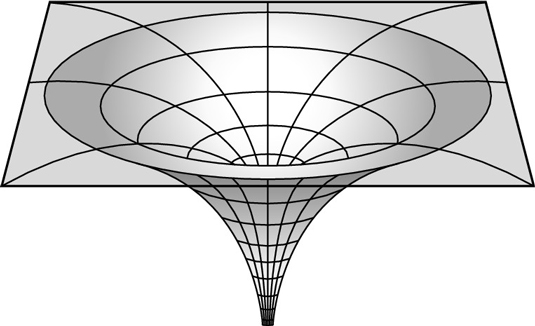If I asked you if you have ever heard of a “compressed star” or a frozen star would you know what I was talking about?
What if I said a Black Hole. Now you know where I’m going with this. It seems like a pretty suitable name. Black because no light is emitted from them, and hole because anything that falls in won’t get back out. The name compressed star is actually more suitable in some ways, giving insight into what a black hole really is. If you took any star and compressed it to a small enough volume, its gravitational pull would be great enough for it to be a black hole. A little more on this later; first, a little bit about these “black holes.”
A black hole obviously fits into its own category. Some consider them to be formed by stars but that really doesn’t matter too much. A black hole is formed when a significant amount mass concentrated into a small enough area, creates a gravitational pull so strong that even light cannot escape it. Now you may be thinking, how, if light can travel through space at such immense speeds without needing a medium, can it be sucked in by anything? This is because of the nature of the spacetime in which our universe exists, the “fabric” of spacetime. The name black hole is slightly deceiving because it is not an actual hole in the fabric of spacetime. I will explain this more in a later post, but Einstein described gravity in his general theory of relativity as the bending of spacetime fabric. The greater the mass, the greater the effect on the fabric. Black holes have such large gravitational pulls, causing a bending in spacetime that creates a curvature approaching infinity. This is why light cannot escape.

Now black holes don’t just go around sucking everything into them; we wouldn’t have a universe if that were the case. Black holes have what has been termed their event horizon – “the one-way surface of a black hole; once penetrated, the laws of gravity ensure that there is no turning back, no escaping the powerful gravitational grip of the black hole” (Brian Greene). Once inside of the event horizon, all mass is ripped to shreds as the increasing gravity pulls at such a drastically higher rate at the close end than the far end that matter closer to the center of the black hole is accelerated faster than matter just a minuscule distance further out.
Outside of the event horizon, though, objects and light are affected in the same way as stars affect them; the curvature of the spacetime fabric outside of the event horizon is very similar to the curvature around massive stars.
Now to put this force into perspective (other than the fact that even light can’t escape it). If you wanted to make a black hole out of our sun, you would have to compress it so that its radius was less than 0.0005% of the original. If you wanted to make the Earth a black hole, you would have to takes its radius of 3963.17 miles and reduce it to less than half an inch.
